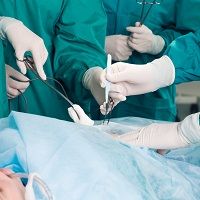Ventral Hernia: More Complications after Laparoscopic Surgery repair
According to researchers in Germany, complications and higher recurrence rates are more likely after laparoscopic ventral hernia repair.

Surgeons have a number of techniques available for ventral hernia repair, and which at best is controversial. One approach is to use intraperitoneal onlay mesh (IPOM). The IPOM technique augments (as opposed to reconstructs) the abdominal wall. A team of German researchers published a cohort study that indicated that complications and higher recurrence rates are more likely after laparoscopic ventral hernia repair.
This study focused on incisional and recurrent hernias. The researchers enrolled 149 patients with abdominal wall hernias who underwent IPOM during a 5-year period (2006 to 2010).
They divided patients into 2 groups: 51 patients had a primary hernia and 98 patients had preceding abdominal surgery. Among patients with preceding abdominal surgery, 64 patients had an incisional hernia and 34 patients had a recurrent hernia. In the preceding abdominal surgery group, 32.7% of all hernias followed intra-abdominal carcinoma operations. Obesity is a risk factor for recurrence; in this study, patients’ average body mass index was 30.3 kg/m2.
Mean duration of surgery was significantly longer in patients who had had preceding abdominal surgeries, as was length of stay.
An interesting finding was that most patients with chronic obstructive pulmonary disease (COPD) fell into the recurrent hernia group, which the researchers interpret as underscoring the fact that COPD impairs wound healing.
Overall, 18.1% of patients experienced minor complications, with patients who had had preceding abdominal surgery significantly more likely to experience minor complications in group II (7.8% in the primary hernia group vs. 23.5% in the preceding abdominal surgery). They were also significantly more likely (14.3%) to experience major complications than patients in the primary hernia group (2%).
Recurrence was also more likely in patients who had had preceding abdominal surgery. They were approximate 4 times as likely to experience recurrence and 5 times as likely for that recurrence to occur early.
The authors conclude that laparoscopic treatment of primary hernias appears safe, but complex hernias as incisional hernias, recurrent hernias and hernias with interenteric and enteroperitoneal adhesions may need a different approach.